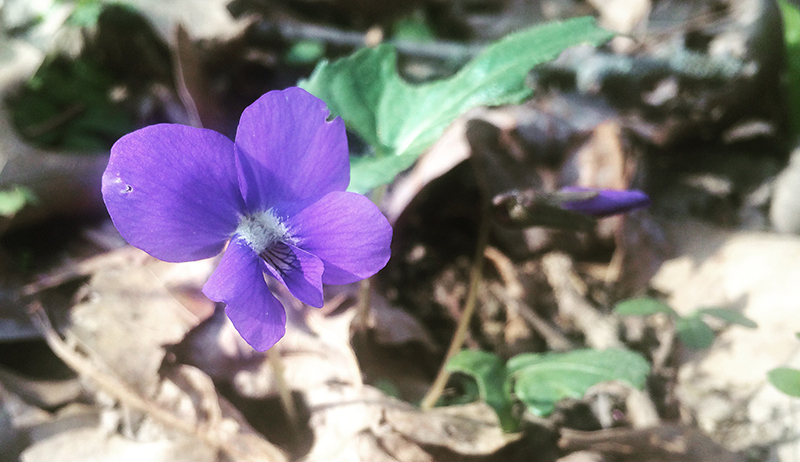
One of the first flowers to pop up around my house each spring is the violet, shy and humble yet highly useful. Often overlooked or considered pesky weeds, violets possess some pretty impressive qualities. The edible flowers are high in vitamin C and can be candied or added to salads, while the leaves have traditionally been used in herbal remedies (such as the balm covered in this article) to treat a variety of conditions including sore throats, congestion and skin irritations. The science community is studying violet extracts for their promising anti-cancer benefits and to treat hypertension.
In this project, we’re going to harness the tradition of using violet leaves on damaged skin to make a soothing lip balm, perfect for healing lips that have been battered by this winter’s harsh weather.
Violet-Leaf Infused Oil
Before making this lip balm, first make a violet-leaf infused oil. To do so, gather up several handfuls of fresh, unsprayed violet leaves. Rinse lightly, if needed, then spread out in a single layer on clean dishtowels or paper towels. Let them air dry for at least one to two days, turning once or twice during that time. This will allow most of the water content to evaporate from the leaves, reducing any chance of spoilage.
Once the leaves are dried, fill a mason jar about half way with them. Pour a light oil, such as olive or sunflower oil, into the jar until it’s almost full. If using freshly dried leaves, I secure a layer of cheesecloth over my jar with a rubber band so that any residual traces of moisture can evaporate. If using leaves that have been dried for several weeks or longer, I cap with a regular canning lid. Tuck this oil away in a dark cupboard for about four weeks, shaking occasionally.
If you’d like to speed up the process, set the uncovered jar in a saucepan filled with a few inches of barely simmering water. Let it steep in this makeshift double boiler for a few hours, monitoring carefully to ensure the oil doesn’t overheat.
Once your oil has finished infusing the slow or speedy way, strain out the spent leaves, and store in a cool, dark place. The shelf life of this oil is about one year. It makes a great addition to salves, balms and soaps.
Making the Lip Balm
Ingredients
- 3 1/2 tablespoons violet-leaf infused oil. (See URL URL URL 73 for details.)
- 1/2 tablespoon castor oil
- alkanet-root-infused oil for a natural tint (optional; see above)
- 1 tablespoon shea or mango butter
- 1 tablespoon beeswax
- 5 to 10 drops peppermint essential oil (optional)
Preparation
Combine the oils—including the alkanet-infused oil, if using—butter and beeswax in a small, heat-proof container. You can recycle a tin can for this purpose to make cleanup easier. Set the heat-proof container in a saucepan containing a few inches of water, and heat to almost a simmer.
Once the ingredients have melted together, remove from heat, and add peppermint essential oil, if desired. Pour into small tins or lip balm sliders and allow to cool, undisturbed.
Cap, label and store in a cool, dark place. Use in six to nine months for optimal freshness.
Notes for Success
This lip balm recipe fills five to six 1/2-ounce round tins. It’s designed to be applied with your fingertips from a small container.
To obtain a firmer texture for lip balm tubes, decrease the amount of violet leaf infused oil by 1/2 to 1 tablespoon. Conversely, if you’d like a softer consistency than the recipe makes, remelt and add extra oil.
Don’t feel limited to using just olive or sunflower oil. You can also try jojoba, sweet almond, avocado, hemp, apricot kernel or tamanu oil.
Cocoa butter can be used instead of shea or mango butter, but be aware of potential allergy that manifests itself as redness or worsening of chapped lip conditions. You can also completely leave out the butter portion of the recipe, for a different type of lip balm.
To make this lip balm vegan, substitute the beeswax with 1/2 tablespoon candelilla wax.
The castor oil in this recipe gives lips a smooth, glossy look and feel. If you’d like a more matte texture, replace it with additional violet leaf infused oil.
This article appeared in Healing Herbs, a 2018 specialty publication produced by the editors and writers of Hobby Farms magazine. Aside from this piece, Healing Herbs includes articles on herbs that can help with pain relief, sleeplessness and stress relief; herbs for teas; how to cut and dry herbs; preparing and preserving herbs; and becoming an herbalist. You can purchase this volume, Hobby Farms back issues as well as special editions such as Living Off the Grid and Best of Urban Farm by following this link.




